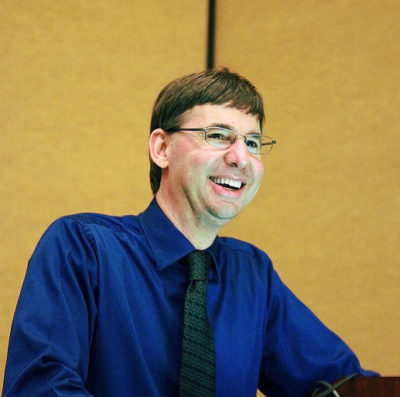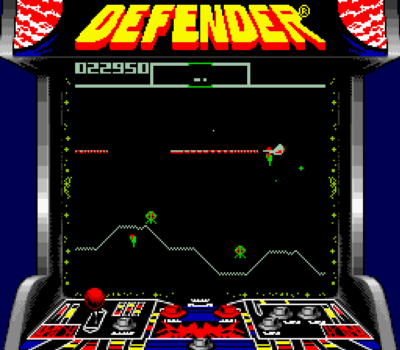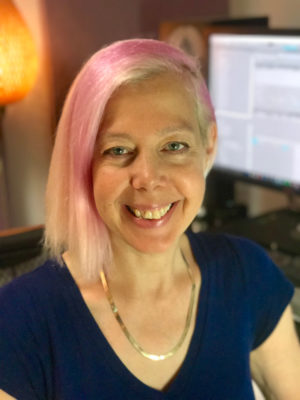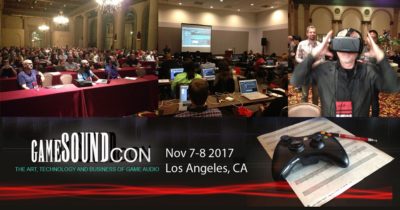Game Audio is Accelerating: The View from GameSoundCon 2017
There are more professional CONventions every year, so how do you direct your time and money in the right direction and avoid getting conned?
For audio practitioners, one of the smart selections is GameSoundCon 2017, taking place November 7-8 in Los Angeles (register with the code SCOOPGAMER for discounted admission). It’s a show that’s been growing steadily for the last eight years, with the mission of advancing “the art, technology and business of game audio.” This year’s speaker lineup will see insights from the musical brains behind HALO, World of Warcraft, Street Fighter V, Bioshock2, Google’s Tilt Brush, Forza, and many more. Together, attendees and presenters move the sonic portion forward for a gaming industry accounting for $70-80 billion gross revenue worldwide in 2016 – a big business that’s only getting bigger.
GameSoundCon was borne from the mind of Brian Schmidt, a seasoned expert in the field, who’s created a lot of other things as well. He went from being a pinball game composer in the 1980’s to writing music for iconic video games like NARC, John Madden Football, the Desert Strike Series, and Crueball. But that’s not all: from there, Schmidt became the primary architect for Microsoft’s Xbox audio and music system, and developed the XMA audio compression format from there. In 2012, Schmidt was elected president of the influential Game Audio Network Guild (G.A.N.G.), a title he still holds.
From the current tech trends and economics, to VR, AR, and GTA, there may be no better person to overview this fastest-moving audio sector. How is game sound today actually like film music of a century ago, and where are the brightest opportunities for audio pros now? Brian Schmidt reveals all in this extended-play Q&A.
Brian, when did you launch GameSoundCon? In what ways is the convention the same as when it was launched, and in what ways has it changed?
When I started GameSoundCon back in 2009, it was quite a bit smaller and more boutique feeling that it is today. We had a single room, and the talks were all geared towards people who might be experienced in more traditional media like film or TV, but who had little or no experience in games. It was a “Game Audio 101 crash course” over two days.
Since then we’ve expanded quite a bit. We broadened the content to include a series of sessions geared towards the seasoned game audio professional—talks covering what some of the very advanced things are going in the top games and by no means are “101” talks. We still have the “101” talks, which we now call the “Game Audio Essentials” track, but have added the “Game Audio Professional” track as well.
New this year is another full session track dedicated solely to Audio for Virtual Reality (as well as its close cousins Augmented and Mixed Reality). We also added hands-on training courses from the companies that make specialized game audio tools like Wwise from Audiokinetic.
And along the way, we’ve added things like a dedicated room for our sponsors, where attendees can see demonstrations of cool game audio technology and talk with the people who create it as well as informal roundtable mentoring, where you can talk with many of the conferences speakers and panelists, either 1-on-1 or in small groups.
So all in all, we’ve gone from a fairly small conference (the first GameSoundCon had around 45 attendees) in a single room to over 350 attendees, with 4 concurrent sessions, spread out over 6 rooms. It’s been fun to see it grow, and get to know some of the attendees, who return year to year.
What I’ve been fortunate enough to have remain the same is the incredible support I get from the game audio community—very busy people, often the at the top of what they do, take time to share and network with others in the community and to help those just getting into it by sharing very openly.
What do you think distinguishes people who concentrate in game sound from those in other sound/audio fields?
I think there’s far more in common that there are differences—a love and passion for creating great music, or careful, detailed sound design. A desire to use sound and music to contribute to a visual story, and so on. I think these are traits shared by anyone who does music or sound for media for a living, of any type.
If I had to focus on the differences, it might be that game audio people seem to like the “puzzle” aspect of game sound. How do we take an inherently linear medium like music and map it onto an inherently non-linear medium like video games? What cool techniques can we come up with to try to make interesting sound effect that can vary based on what the player is doing?
And of course, many of the most successful game audio professionals enjoy games. Not all game audio people are 20-hour-a-week gamers of course, but we all have our favorite game genres, and just love the medium and the creative, technical and business challenges it presents.
So how do these differences translate into a unique community of professionals, and how is GameSoundCon designed to meet their specific needs?
Even among the broader game industry in general, the game audio community is known for its surprisingly open and accommodating environment. We have formal organizations like the Game Audio Network Guild or ia-sig (Interactive Audio Special Interest Group of the MMA) or the Audio Mentoring Project as well as less formal ones such as the Game Audio Denizens facebook group or Video Game Composers and Sound Designers.
What they all have in common is that the people in them are for the most part more than happy to share their techniques, tools, tips and tricks, etc… with each other. And many of the movers and shakers in the industry are very approachable, down-to-earth people, quite willing to spend 10 minutes talking with a student or novice. People new to game audio are very surprised by that.
GameSoundCon is architected to try to allow for that person-to-person interaction, as much as possible. For example, last year, we invited a number of researchers in audio technology to speak—the idea was to get the people who do cool, general audio technology research talking to the composers and sound designers who use audio technology in games, and see what happens. We also have the rooms set up to facilitate person to person or informal small group mentoring and discussion to organically spring up. It’s fun to overhear some of the conversations that take place!
One of the distinguishing thing about GameSoundCon is, because it’s solely dedicated to game audio, is that the speakers and panelists aren’t busy themselves with meeting with game companies (like they might be at a larger conference). They’re just there to share and interact with the community and do intra-industry networking.
I sometimes, only half-jokingly, remark that one of the reasons that our community is so open is that game audio is really fairly complex, with a lot of under-the-hood nuances which are hard to see. So once we find someone willing to listen to us talk about it, we are so grateful that someone appears interested that you can’t get us to shut up about it.
Careers Beyond Composing
When people discuss game sound, many think about composers first and foremost, but there are many other roles people can play in the field. What are some of the fastest growing career tracks in game audio, and why?
Game audio is fairly diverse, but so far hasn’t quite specialized as much as, say, a composition or sound design for a full-length feature film has. That said, there are many other career tracks in game audio. Game Sound Design has its own set of unique challenges, quite different from linear (film, TV, etc…) sound design, because sounds have to be malleable and interactive. That requires a different set of skills from traditional Foley art, for example.
One of the faster-growing career tracks is that of “Technical Sound Designer or Technical Composer.” This is a role that has no counterpart in linear media. The Technical Sound Designer serves as a middleman between the composer or sound designer and the game itself. The act of placing sounds into a game can be fairly technical, from using custom game audio tools all the way down to writing computer code in C# or C++.
“Sound Designers who can implement” is also a good field. Just about every job posting for game sound designers (yes, a lot of companies hire full-time employees to be composers, sound designers and/or audio directors) has listed as a requirement the ability to “script” (simple computer programming).
So while at the end of the day it’s the quality of the music or sound design that matters most, a close second is the ability to see interactive possibilities in that music or sound and know how to put those ideas into action in the game.
How is the game audio industry itself growing – are there revenue numbers or other metrics to indicate economic trends?
Games in general have been very fast growing—In 2016, I believe that in the United States the totality of the video game industry pulled in over $26 Billion in gross revenue. Worldwide estimates are in the $70-80 billion range. Of that, the fastest growing has been mobile/casual games, which has been on a tear since the opening of “App stores” and Facebook’s game initiatives. The creation of iPhone games opened up a great many game audio jobs.
That said, one of my big pet peeves is the persistent misconception that “Games are bigger than movies.” No question that games are huge and a growing part of peoples’ entertainment dollars, but it’s not true yet that games are bigger than movies.
One thing that people do find surprising are some of the stats on demographics. For example, more adult women play video games on a regular basis than teenage boys. Part of that is of course is that there are many more women over 35 than there are men under 21, but it is also that there are many more genres of games than most people realize—not all video games are shoot-em-up, alien sci-fi games. Puzzle and casual games are exceedingly popular, and broaden the demographic of the “gamer” significantly.
By some estimates in 2016, over 500 new games were added to the Apple App Store… per day! We have a brand new generation who, for the first time in history, has grown up accustomed to having a connected, powerful computer in their pocket. So the long-term outlook is quite good.
The Genesis of GameSoundCon
You’ve had an extremely diverse career in game audio, from composing for pinball games to becoming the architect of the Xbox’s audio and music system, to developing the XMA audio compression format. How would you characterize the arc of your career — how was it naturally led to founding industry initiatives like GameSoundCon?
I’ve had a couple interesting pivots, but underlying it has been a foundation consisting of three main things: A love of music and sound, fascination of how technology can be used to create and affect music and sound, and finally a quirky passion for meshing these together to drive games and interactive entertainment.
I’ve always loved playing pinball, going back to being a 10-year-old riding my bike up to the arcade and spending my allowance on pinball. So when I had an opportunity to actually work at the company that made these games I loved growing up, I jumped at the opportunity. And as luck would have it, I was just graduating with degrees in music and computer science right at the time this company needed someone who could both compose music and program “assembly language.”
I learned a ton from being around some legendary game developers—people who made games like Robotron, Defender, NARC, Mortal Kombat, and learned how technology can be pushed to its limits, in the service of a creative vision.
After a decade of freelancing, I was asked to head up game audio technology at Microsoft and the Xbox program. One of the most fun aspects of my job was to fly around and help teach composers and sound designers understand how to take advantage of the Xbox’s powerful audio system. It was there that I noticed that many of these composers and sound designers —many of whom were coming from more traditional media backgrounds in film or TV— were stumbling over the same issues over and over as they worked on their first or second games—things that were just so very different in games, compared to what they were accustomed to in the film/TV/music industry.
That was back in 2001, and it’s when I first thought, “Wow, there is a real need for something to educate composers and sound designers on how doing sound for games is so very different from film and TV.” I’d also grown up in an environment of music education; both my parents were music educators. I also have great memories of music education I’d received, all the way from my public school music teachers through college, so the idea of adding “education” to my career felt quite natural.
So when I left Microsoft in 2008, I’d written a four-pillar plan for my post-Microsoft life, one of which was “create a conference where people can go to learn about game audio.” The first GameSoundCon was a year later.
This year’s program features everything from “Introduction to Game Audio” to Interactive Music and VR tracks. How was this year’s agenda planned – how did you decide what classes to include? What is their common thread?
The subheading for GameSoundCon has always been “The Art, Technology and Business of Game Audio” and those 3 pillars serve as the foundation. As I mentioned, I do separate out the talks by session track. Each track is a full 2-days of content. “Game Audio Essentials” is for those who are new to games, or with maybe only a couple games under their belts. I do a semi-deep, but broad coverage of the creative, technical and business aspects of the industry, with an emphasis on how it differs from Film other linear media.
For the “Game Audio Professional” track, I also try line up talks that cover the 3 pillars, but with deeper content. I like game post morta, because they really show what the top end games are doing, and how they’re achieving it, as well as lessons learned. The talks often feature a “we thought XYZ would be awesome—turns out it wasn’t” component.
I also try to think things like “if I were a composer and just not interested in sound design” what can I get out of GameSoundCon? So, for example, on the first day of the ‘essentials’ track, we cover interactive music, while on in the pro track, music is highlighted on the second day. So a composer might do day one in ‘essentials’ and day two in ‘pro.’ (That said, I do recommend that anyone new to games spend most or all of their time in the “essentials” track).
And for the new “VR Audio Track” — a “conference within a conference” — I’ve got two great co-chairs, Sally-Anne Kellaway and Linda Gedemer, two of the very top people in audio for virtual reality. They put together a great set of sessions that cover both detailed, technical talks as well as high-level aesthetic talks.
That’s an inspirational “signal path!” Turning to 2017, this year’s Keynote Session is led by Becky Allen, Audio Director Electronic Arts/PopCap. How was she chosen to keynote, and what will she focus on?
I’ve known Becky for 15+ years now—her career in interactive has spanned more than two decades, in companies ranging from SoundDelux to Microsoft and Electronic Arts/Popcap. Along the way her career has taken some interesting detours—as all careers do.
Her keynote is entitled “Perseverance, Pivots and Partners.”
In a keynote, I’m always looking for someone who will inspire, and who can inform through personal experience their views of creating and maintaining a successful, sustaining career. Becky also has a unique perspective as a woman in the industry, and how she’s seen things change (or stay the same) from a demographics perspective and how the game industry—which has had more than its share of diversity issues—has wrestled with itself. I’m really looking forward to sitting in the crowd for this one!
Who’s Coming to the ‘Con
Who should come to GameSoundCon – what are the various attendees that the show attracts? What do you hope that people who attend the conference come away with?
GameSoundCon was designed for:
- Composers and sounds designers, audio engineers or people familiar with traditional media, but who don’t know the creative, technical and business challenges of working in games, and want to learn.
- Seasoned, experienced game audio professionals who want to keep abreast of the cutting-edge, start-of-the art in game audio
- Anyone interested in how the tidal wave of virtual and augmented reality affects composers, sound designers and creators of music technology—not only for games, but actually also for semi-linear media as well.
While there are obviously concrete items I hope attendees will walk away with (how do composers integrate music into games? What is a “parameterized sound effect?” “How did Neal Acree approach the score to his latest game?” etc…), what I really hope for is that people will walk away inspired and excited by game audio and the people in it. I hope they will make some new friends and enjoy getting caught up with old ones and to feel welcomed by and a part of the game audio community.
One totally unexpected byproduct of GameSoundCon for me personally is how it re-energizes me and reminds me that –despite the stress of deadlines, and the sometimes grinding day-to day-work—how very fortunate we are to work in this industry, and with these people as colleagues and friends.
Finally, where do you personally see game audio headed? Why is this a challenging time to be involved with game audio, and conversely what are the Big Opportunities that you see?
Wow, this could be a whole interview in and of itself! I like to think of game audio right now being about where film was in the ‘20’s. We are still learning what does and doesn’t work. Our tools—even the awesome tools like Elias, Wwise, FMOD, ADX2, etc, are still fairly primitive and are simultaneously empowering and limiting.
Once you start working a game, you find yourself thinking, “Wow…what I really want is for when XXX happens in the game, to do YYY,” and very often the tools don’t support quite what you had in mind creatively. If you’re lucky, you can have a programmer write some code to make it happen, or maybe find some clever way—using the tools completely against what they were designed for—and getting something close to what you envisioned.
At the same time, we’ll also see people taking advantage of the immense computational power in game systems now—High-end Virtual Reality rendering of environments—that’s a whole new set of creative, technical and business challenges!
There will always be “Big Opportunities” for creative composers and sound designers who can drive just a bit past their headlights– try things just a bit beyond what has become normal—and create music and sound design that forges new, not well-explored areas of game music, sound design and technology.
— David Weiss
GameSoundCon 2017 takes place November 7-8, at the Millennium Biltmore Hotel, Los Angeles. Register with the code SCOOPGAMER for discounted admission.
Please note: When you buy products through links on this page, we may earn an affiliate commission.











